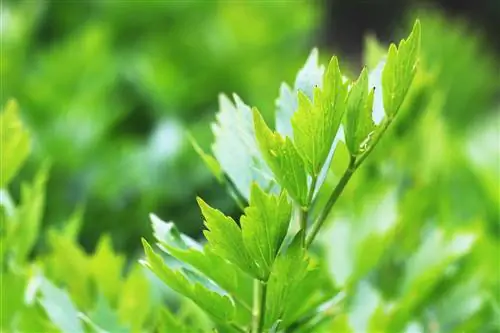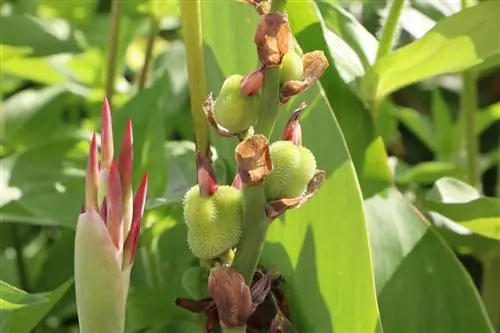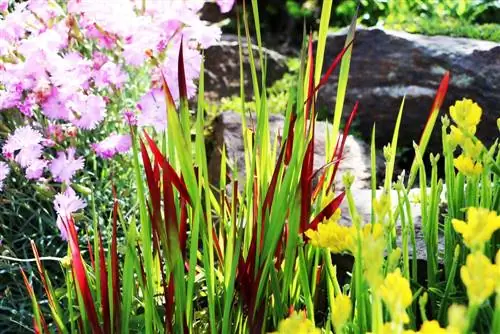- Author admin [email protected].
- Public 2023-12-17 03:39.
- Last modified 2025-01-24 12:45.
When Bleeding Heart blooms in May, it touches the heart of every gardener. These delicate flowers, which are lined up on the stems amidst the green leaves of the perennial, are also the reason why bleeding heart is so popular. But what should you pay attention to when pruning so that it remains as magnificent year after year?
Is a cut necessary?
Bleeding Heart, also affectionately known as Flaming Heart, Mary's Heart, Two-Tone Heart Flower or Herzerlstock, has long since found its way from traditional cottage gardens into home gardens and parks. In addition to its decorative appearance, this is probably also due to its simple and undemanding care. There is no need for topiary at all, unlike many other perennials that require cutting.
Bleeding heart is most beautiful when it is allowed to develop its natural growth. It develops a beautiful and compact shape on its own. Gentle pruning is only necessary after flowering. If cutting is no longer necessary for time or other reasons, it still has no negative effects on the perennial.
In these cases a cut is appropriate
Although Bleeding Heart, which is botanically called Lamprocapnos spectabilis, does not need pruning, some pruning measures can be useful. This usually involves influencing plant behavior or carrying out visual beautification measures. In these situations, bleeding hearts can or should be cut:
- Flowers have faded
- Yellowing spoils the appearance
- bleeding heart should be increased/rejuvenated
- a fungal disease has spread
- neighboring plants have little space
- Blossoms are needed for a bouquet
The right time to cut
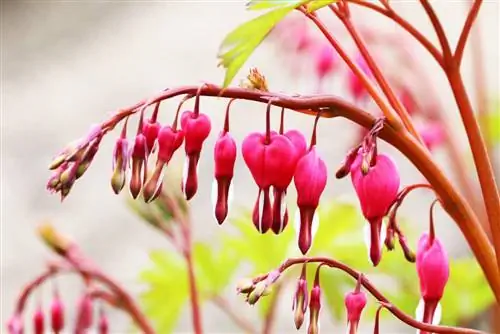
If the exotic-looking flowering perennial is affected by a fungal disease, it should be pruned immediately so that the pathogen cannot damage the plant further. Reacting quickly also protects neighboring plants from infection. Flower stems for the vase are cut as needed. However, most other pruning measures can wait until after flowering. The flowering season is usually over at the end of July, now you can gradually cut back the bleeding heart. It's best to wait until late autumn or winter to use root cuttings for rejuvenation.
Don't cut back too early
If cutting is not a must, for example if you are sick, then wait until the foliage begins to wilt. Under no circumstances should you cut Bleeding Heart too early. The period shortly after flowering is an important time in which the perennial gathers strength for the next year. If you ignore this, you may be annoyed by sparse flowering next year. Once the Bleeding Heart has faded, it is possible to cut it back without hesitation.
Warning: Bleeding Heart is a poisonous beauty
The perennial that delights us with heart-shaped flowers is also a highly poisonous plant. In 2017, bleeding heart was even poisonous plant of the year. If the skin comes into contact with the plant sap while caring for this perennial, contact allergies result. Since plant sap can escape when cutting, you should definitely take appropriate protective measures.
Protective measures when cutting
When caring for poisonous plants, protective measures are essential so that the plant's poison cannot harm you. Plant sap can escape, especially when pruning, and irritate the skin.
- Always use gardening gloves.
- Clean the cutting tool with water - before and after cutting!
- Disinfect the cutting blades with alcohol - before and after cutting!
- Don't leave cut parts of plants lying around.
Tip:
When caring for this poisonous plant, it is best to use disposable gloves that you can then throw away. This will prevent toxic plant sap from remaining on your gloves and irritating your skin at a later date.
Remove spent flowers
The bleeding heart is quite undemanding when it comes to care, so it does not require any pruning. However, if you prune after flowering, you can start a second round of flowering and thus delay the end quite a bit. If the hearts have faded, it is best to cut them off immediately. If these withered stems are left standing, the plant directs its energy there and immediately begins to produce fruits and seeds. So if you prune soon after flowering, the energy saved can be used to produce flowers again. The rootstock also benefits from this and becomes stronger. If you cut the spent flowers:
- Observe the protective measures
- Always use a sharp knife or secateurs
- Remove dead flowers from the stem
- Put wilted flowers in the compost heap, if you have created one.
Tip:
Do not pick or tear out the stems. Other parts of the plant can also be unintentionally plucked out or damaged.
Cut back annoying, yellowed leaves
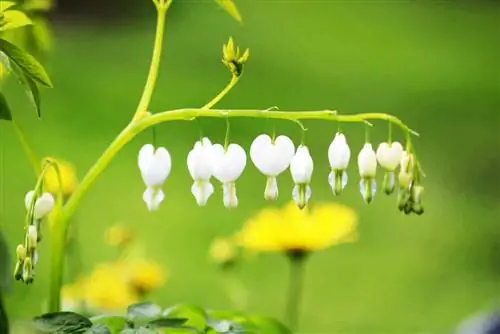
After flowering, the beautiful appearance of the plant is over. Bleeding Heart draws all its strength back into the rootstock. Leaves quickly turn yellow and dry out. Many gardeners don't particularly like the sight of dead leaves. Once the leaves have faded, cutting is possible without any problems. Although no sap flows from dried leaves, protective measures cannot do any harm with this poisonous plant.
Tip:
A garden doesn't always have to be meticulously clean. If you simply leave the withered leaves standing, they will decompose over time and act as a natural fertilizer for the soil. At the same time, the dried leaves are a good hiding place and protection for the smallest animal inhabitants of the garden.
Cutting for fungal disease
If you take proper care of the bleeding heart, it usually stays he althy. However, it can also happen that a fungus attaches itself to the plant and spreads quickly. A quick reaction is necessary so that the fungus has no chance of seriously damaging the entire plant or even causing it to die. A cut is urgently needed and must not be used sparingly. Take care of the diseased plant by cutting off all affected parts right down to the roots. A radical cut can also be carried out as a preventive measure. This way you can make sure you don't miss any sick spots.
- Clean the cutting tool with water
- Then disinfect the cutting surfaces with a cloth soaked in alcohol.
- Use gloves at all times when performing cutting operations.
- Cut off all affected shoots down to the root.
Check whether the fungus has spread to neighboring plants. If necessary, take appropriate measures. This will also protect the bleeding heart from reinfection.
Note:
Sick plant parts do not belong in the compost because the fungus can survive there. If the finished compost is later spread in the garden, the fungal spores will also be present. Therefore, dispose of all plant parts affected by the fungus exclusively with household waste.
Create space for neighboring plants
A variety of flower varieties tempts you to plant densely in the garden, especially when available space is limited. When the Bleeding Heart develops its lush greenery, it could become too crowded for a slow-growing or later-blooming neighboring plant. That would be a shame, because other plants also have their advantages that should be showcased. Here it may be necessary to trim the bleeding heart and thereby give neighboring garden residents more space. The timing of this cut also depends on the needs of the other plant, but should still be done after the Bleeding Heart has bloomed whenever possible.
Tip:
Until the flowering period is over and cutting is possible without hesitation, the bleeding heart can now be loosely tied together on a stick. This gives the plant neighbors more space.
Cut green cuttings for propagation
You definitely want to have more than one specimen of a beautiful plant in your garden. Bleeding Heart is such a beautiful plant that no flower lover can get enough of. You don't have to buy a new plant right away. If you already have a plant, you can easily grow additional perennials from it. Fresh cuttings are a suitable method for obtaining new plants.
- Observe the protective measures and wear gardening gloves
- Pick out a few strong shoots
- The shoots should still be green
- Cut shoots about 15 cm long
- Use a sharp knife or secateurs for all cuts
- never pluck or tear
Tip:
The best time to take cuttings is immediately after flowering. The parts of the plant still have enough juice and the formation of flowers can no longer be disturbed.
Rejuvenating pruning in autumn and winter
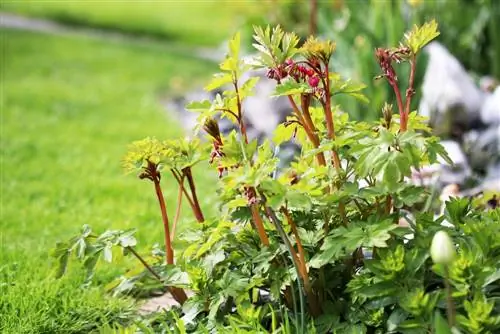
If you miss the right time for green cuttings, a second opportunity awaits in late autumn and winter. The perennial can no longer be seen above the ground because it has quickly retreated into the roots after flowering. That doesn't matter, because Bleeding Heart can also be wonderfully rejuvenated using root cuttings. The best time to take root cuttings is October and November. Please note the following instructions so that the required cut is successful and the plant is not damaged.
- Choose a frost-free day
- Observe the protective measures, always wear gardening gloves
- Use clean and sharp cutting tools
- Expose the root of the plant
- Cut thick pieces of root about 3-5 cm long
- Cover the exposed rootstock again with soil
Tip:
Choose a suitable location for the new plant, as far away from the garden fence as possible. This way, no one passing by can be tempted to grab the invitingly beautiful flower stems - without knowing how poisonous they are!
Cut heart stems for the vase
The delicate hearts awaken romantic feelings. It is therefore tempting to use a few flower stems for a bouquet. A well-grown perennial will produce numerous flower stalks at once, if a few of them are cut for the vase, enough will be left over to decorate the remaining greenery. Regardless of whether the flowers are used to decorate your room at home or are given away as gifts, careful handling of this beautiful but poisonous plant is a must.
Tip:
Not everyone immediately suspects danger behind such a delicate and beautiful plant. If you are giving the flowers as a gift, let the recipient know about it. This is how you give the gift of joy and play it safe at the same time.


